To believe all that has been said of the sea-serpent, or the Kraken, would be credulity[1].
Oliver Goldsmith: A History of the Earth and Animated Nature (Natural History), 1774.
Pirate fiction probably could not exist without the myths, monsters and other imagined mayhem that has ravaged the seas since man first ventured upon it. Some of the myths about the sea and pirates have been part of the human story for thousands of years. As the quote above suggests, most learned men were skeptical of the more rousing tales of seafarers.
Other parts of pirate mythos comes from the minds of great story tellers, long after the Golden Age of Piracy had come to a close. This page will try to explain the origin of some of these myths. The point of the page is not to de-bunk the myth only to explain them.
Below are some of the most common monsters and myths. In all, the monsters and the myths only help to blur the lines between the fact and the fiction of the Golden Age of Piracy.
Images to follow once I draw them or find more copyright free images.
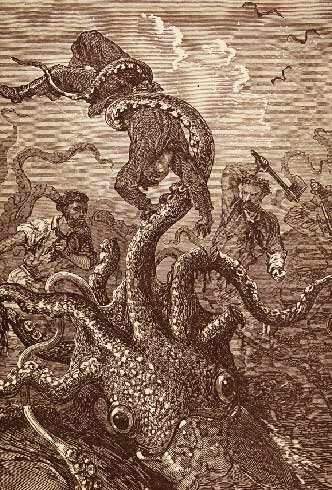
Attack of the Giant Squid (Kraken)
from 20,000 Leagues Under the Sea.

Black Spot
The Black Spot is probably a creation of Robert Louis Stevenson, author of Treasure Island. The Black Spot is a summons given to a pirate as a warning of impending action. Typically, it would be a notice to the captain that he was about to be "deposed" or replaced as captain. Two pirates receive the Black Spot in Treasure Island. The first is Billy Bones, the self declared sea captain. (Billy Bones was actually Captain Flint's helmsman). Long John Silver, is the second pirate to get the Black Spot. At the time of receiving the Spot, he was the Captain of the mutineers. He served as the Hispaniola’s Sea Cook and Captain Flint's Quartermaster.
The Black Spot is pure fiction created by Stevenson. It is a terrific bit of pirate lore these days but probably did not exist during the Golden Age of Piracy. Real pirate captains tended to be deposed by being shot in their sleep, thrown overboard, or marooned. In some case a pirate captain would be deposed by election, but there are more cases of violent revolts documented than smooth transitions of power.
At the time that Stevenson wrote Treasure Island the term Black Spot was used to describe any disease among animals or plants that cause black spots to form. This was especially true of the black spot disease that afflicted Rose Gardens. Perhaps (and this is only speculation on my part) the black spot diseases was part of Stevenson's inspiration. Later after Stevenson's death the term black spot was used to describe places of dread or foreboding.
An excerpt from the novel Treasure Island:
The sea-cook looked at what had been given him."The black spot! I thought so," he observed. "Where might you have got the paper? Why, hillo! Look here, now; this ain't lucky! You've gone and cut this out of a Bible. What fool's cut a Bible?""Ah, there!" said Morgan. "There! Wot did I say? No good'll come o' that, I said.""Well, you've about fixed it now, among you," continued Silver. "You'll all swing now, I reckon. What soft-headed lubber had a Bible?""It was Dick," said one."Dick, was it? Then Dick can get to prayers," said Silver. "He's seen his slice of luck, has Dick, and you may lay to that."But here the long man with the yellow eyes struck in."Belay that talk, John Silver," he said. "This crew has tipped you the black spot in full council, as in dooty bound; just you turn it over, as in dooty bound, and see what's wrote there. Then you can talk.""Thanky, George," replied the sea-cook. "You always was brisk for business, and has the rules by heart, George, as I'm pleased to see. Well, what is it, anyway? Ah! 'Deposed' — that's it, is it? Very pretty wrote, to be sure; like print, I swear. Your hand o' write, George? Why, you was gettin' quite a leadin' man in this here crew. You'll be cap'n next, I shouldn't wonder. Just oblige me with that torch again, will you? This pipe don't draw."Treasure Island, Robert Louis Stevenson, in the Chapter, The Black Spot Again.

Brethren of the Coast
Was there an organized pirate government? The simple answer to this question is "no". This is especially true of the depiction of a pirate government in Pirates of the Caribbean: At World's End.
Despite the legends in books and movies, no real pirate government existed. However, several sources, including Johnson's General History of Pirates claims that organized pirate settlements formed in Madagascar. Tortuga and the Bahamas also lay claim to large pirate settlements. These settlements were not actually pirate governments as much as they were ungoverned territories where pirates could live without fear of civil authority.
While some like to think of the Brethren as a government it is probably wiser to compare the term brethren to gangster. Just as all gangster belong to a crime family, all pirates belong to a ship. And just as rival crime families will often fight each other, not all pirate ships worked together or respected each other. Thus we can assume where one pirate might be welcomed and allowed to stay in a particular location another pirate would be hanged.
When you compare pirates to gangsters some similarities quickly come to mind.
- They prosper where government authority is corrupt or absent
- A main tactic for success is fear and intimidation
- They sometimes embrace the needy in an effort to legitimize their deeds
- Suspicious of strangers
- Have difficulty operating where honest authority exists
- When at all possible avoid directs conflict with law enforcement
- It is difficult for them to operate when the community is hostile towards them
For more on the Brethren of the Coast see: Pirate Government.

Buried Treasure
Most experts on piracy tend to argue that maps to buried treasure are a work of fiction. They also believe that pirate would not have buried treasure on deserted islands. There are two sound reasons for not believing in buried treasure. 1) There has never been a legitimate treasure map found and 2) pirates tended to spend all their money as soon as they hit port and would return to pirating in order to raise more money. Probably the most famous treasure map is that of Captain Flint, the fictional pirate in Stevenson's Treasure Island. Almost every famous pirate captain has a legend about a treasure map to his secret stash of booty. Blackbeard and Black Bart both have several legends about buried treasure.
With that said, the romantic in me says that buried treasure may indeed exist. Some pirate managed to sack and pillage great amounts of gold and silver. I can't imagine a pirate with 10,000 pieces of eight to carry it with him everywhere he went. Where is he going to put the money? Would he put it in a Bank? Probably not. Would he trust his ship mates to watch it for him when he went to tavern? Probably not. Would he find a place to hide it? Yeah, probably. So maybe somewhere on some spit of land, or hidden in a grave yard, or perhaps in a isolated patch of land near an old port or river bank, a pirate buried a barrel or wooden chest with a bunch of doubloons inside. He probably wouldn't draw a map to where it was unless he knew he was going to die and was giving his shares to a partner.
So will you find "Flint's Treasure" amounting to all the riches he obtained over twenty years of pirating? Probably not. But is it possible to find a stash of 1,000 doubloons, or even a couple gold bars buried near an old pirate lair? I would say it is plausible but not probably after two hundred years. One thing would be certain; the pirate would probably hide the money where it was easy for him to get to it but not easy for others to find. He may also set a trap for suspicious fellows who might be in the area.

Calypso
A Greek sea nymph, she was a daughter of Atlas. She was the Goddess of Silence. Being a bored lass she made it her point in life to make sure people did not complete there tasks. she was also known as the goddess of deception because of her ability to distract sailors with her beauty only to lead them to ruin and destruction because they failed to pay attention to what they were suppose to be doing.
A new back story is created for Calypso in the Pirates of the Caribbean movies. She plays and important part in the final installment of the Trilogy.

Cats
Seafarers were a superstitious lot. During the Golden Age of Piracy (and still today in some circles) Seafarers, considered the possession of black cats good luck. It was a common practice for the loved ones of a merchant marine to keep a black cat in the house while he was at sea. It was believed that so long as the cat was well fed and kept safe from harm, nothing would happen to the mariner.
Sailors also kept cats on board ships to bring them luck. Some of the superstitions involving sailors and cats claimed if the ship's cat approached a sailor, it meant good luck. If the cat approached halfway and turned away, bad luck would surely follow. If a cat was thrown overboard, a storm would rise and very bad luck would follow.
Polydactyl cats (cats with extra toes) were always a good thing on board ships. Sailors were long-known to especially value polydactyl cats for their extraordinary climbing and hunting abilities as an aid in controlling shipboard rodents. Some sailors also considered them to be extremely good luck when at sea. Today, such cats are found throughout England and the Eastern Seaboard of the United States!
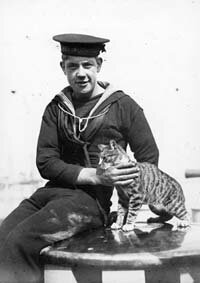
WWII photograph of a Royal Navy Rating and the Ship's Cat.
If other seafarers believed this then there is no reason to doubt that a pirate or his lover would not hold the same beliefs. On a more practical note, the cat would help keep down the rodent population. The cat on a ship is usually referred to as the "Ship's Cat".

The Pirate Code
Was there a real Pirate Code? To be honest, at best it really was more like guidelines . The pirate code really is pure literary fiction and was developed from ship's articles found on some pirate ships. There was no written Pirate Codex as portrayed in Pirates of the Caribbean, at World's End.
Other than these boasts and ship's articles, there was no real pirate code. Furthermore, from the few surviving ship's articles their is evidence that not every ship was ran the same way which leads one to believe that no universal code existed and if it did, it was not followed. There is also was no proof pirate council or pirate king controlling all the oceans (or even a single ocean).
For more on the Brethren of the Coast see: Pirate Government.

Davy Jones Locker
Davy Jones' Locker is a nautical term that dates back to at least 1751 (first known written reference to the word). It is quite possible that the term existed orally among sailors before this date. Since it's first historical mention, the meaning of Davy Jones has changed very little. Davy Jones was sailor slang for the Devil or other evil spirits of the ocean. Davy's Locker or Davy Jones' Locker was the deep ocean's bottom. To be sent to Davy's Locker was to perish at sea. To send someone to Davy Jones was to kill him or her. It should be understood that a person going to Davy Jones usually was not going to Heaven.
The phrase Davy Jones appears in much of the popular nautical literature. There is no reason not to assume the term was common among sailors for many years. Other variations of Davy Jones' Locker are:
- To be in Davy's Grip: To be close to death, or frightened
- To have the Davies or the Joneseys: To be frightened
- To see you to Davy Jones: To threaten to kill some one
- Awaken Davy or Awaken Davy Jones: To cause a storm
To give credit where it is due, The movie POTC, Dead Mans Chest gives a back story for the creation of Davy Jones. This is a piece of original fiction created for the movie and not part of the myth over the years. Davy Jones wasn't the Captain of the Flying Dutchman or Black Pearl. the story was created by the writers of the movie script.

Flying Dutchman
The Dutchman is a ghost ship that can never return to port for some reason. Its origins are unclear, being traced back to a novel, a play, short story and an opera. Most people attribute the ship to Dutch Captain named Bernard Fokke. Old Bernie had a habit of breaking his own speed records while sailing between Holland and the Dutch East Indies. People claimed he must have made a pact with the Devil in order to make his trips so quickly.
Well ol' Bernie ran into a tempest as he was rounding the Cape of Good Hope (tip of Southern Africa) but refused to give into the storm. As the storm worsened his crew begged him to turn around but he swore an oath and said he would sail through the storm even if it took him until judgement day. Needless to say the ship was lost with all hands aboard. (Which makes you wonder who managed to pass on the story about Fokke issuing the oath?) The story dates from as early as 1641. It bears a strange resemblance to early folktales of the Wandering Jew.
Since then, Flying Dutchman has made repeated appearances on Sponge Bob Square Pants, The Pitates of the Caribbean Trilogy, and numerous screen adaptations under the title Flying Duthman or De Vliegende Hollander dating from as early as 1923.

Green Flash
The green flash is a naturally occurring phenomenon where there is sudden flash of emerald green light as the sun sets. This can happen when the horizon and the sky are both crystal clear. It is more common over the ocean but happens over land as well.
Well documented cases of date back to the 1600s but it became more common with longer sea voyages and polar exploration. One of the biggest myths of the green flash was created by Jules Vernes. He claimed it to be an old Scottish legend that 'if one were to peer in the light of the green flash they would gain the power to read the very souls of other people they met'. There was no Scottish myth. Other people claim that the Ancient Egyptians wrote story about mystical powers of the green flash.
Verne was an avid sailor and astronomer so he was probably very knowledgeable about the green flash. Also of note, in his book 20,000 Leagues Under the Sea the protagonist of the story has a fight with a giant octopus, the monster commonly known as the "kraken" in nautical lore.

Jonah
As early as 1611 there are written accounts that describe a Jonah as a person that bring bad luck to ship. Typically a person is marked as someone who cause bad luck to befall a ship. when it happens there is little else to do but get rid of the Jonah, as in throw him overboard. If trouble dissipates, the crew found the right person. If the trouble persists, it may be they grabbed the wrong person and the ship is now cursed by the blood of a righteous person who was killed. The crew may then decide that the only way to appease the spirit of the dead (or spright) is to toss overboard the accuser of the innocent man.
The name comes from the Old Testament of the Bible. Jonah was a prophet that was swallowed by a great fish (commonly considered a whale these days). In a broader sense, anything or anyone that brings bad luck is a "Jonah".
From the New American Bible, Jonah 1: 1-16.
This is the word of the LORD that came to Jonah, son of Amittai: "Set out for the great city of Nineveh, and preach against it; their wickedness has come up before me."
But Jonah made ready to flee to Tarshish away from the LORD. He went down to Joppa, found a ship going to Tarshish, paid the fare, and went aboard to journey with them to Tarshish, away from the LORD.
The LORD, however, hurled a violent wind upon the sea, and in the furious tempest that arose the ship was on the point of breaking up.
Then the mariners became frightened and each one cried to his god. To lighten the ship for themselves, they threw its cargo into the sea. Meanwhile, Jonah had gone down into the hold of the ship, and lay there fast asleep.
The captain came to him and said, "What are you doing asleep? Rise up, call upon your God! Perhaps God will be mindful of us so that we may not perish."
Then they said to one another, "Come, let us cast lots to find out on whose account we have met with this misfortune." So they cast lots, and thus singled out Jonah."Tell us," they said, "what is your business? Where do you come from? What is your country, and to what people do you belong?"
"I am a Hebrew," Jonah answered them; "I worship the LORD, the God of heaven, who made the sea and the dry land." Now the men were seized with great fear and said to him, "How could you do such a thing!"
They knew that he was fleeing from the LORD, because he had told them.
"What shall we do with you," they asked, "that the sea may quiet down for us?"
For the sea was growing more and more turbulent. Jonah said to them, "Pick me up and throw me into the sea, that it may quiet down for you; since I know it is because of me that this violent storm has come upon you."
Still the men rowed hard to regain the land, but they could not, for the sea grew ever more turbulent.
Then they cried to the LORD: "We beseech you, O LORD, let us not perish for taking this man's life; do not charge us with shedding innocent blood, for you, LORD, have done as you saw fit."
Then they took Jonah and threw him into the sea, and the sea's raging abated. Struck with great fear of the LORD, the men offered sacrifice and made vows to him.

Kraken
The Kraken dates back to at least 1752 and probably earlier. The word came to the English from Norwegian. The Norwegians called the Kraken, sykraken, sjökrakjen or sea-kraken. The Kraken is an enormous monster capable of pulling a ship and its crew under the sea in a single jerk. The Kraken has been around in movies for a while but it was not called a kraken in any of the movies until Pirates of the Caribbean II, Dead Man's Chest. The kraken also appeared in Mysterious Island and 20,000 Leagues Under the Sea, stories written by Jules Verne.
The kraken was always described as giant squid or octopus. Ancient whalers saw evidence of the kraken when they harvested sperm whale and saw suction cup marks similar to those of octopus or squids on the side of the whales. The kraken was always considered mythical, typically measuring as much as 200 or 300 feet in length.
Today we know there may be real kraken in the ocean; however they do not reach lengths of 200 feet. The giant squid is believed to be a living example of a kraken. While the giant squid could not pull down a man-o-war, it would be big enough to capsize or sink a small boat and could easily kill a man if it chose to do so. Real krakens are giant squids reach a length of perhaps 46 feet.
Despite their tremendous size, Sperm whales seem to like to eat giant squid. It is possible that some of the early specimens of the kraken were those found in the stomachs of sperm whales after whalers had harpooned and gutted them. imagine the terror of finding bits of giant squid in the belly of sperm whale? Imagine sailors assuming the sperm whale ate the squid after a terrific battle. Knowing how many men sperm whales had killed while men hunted them, the sailors could only imagine the worst when seeing the remains of this horrific giant monster found within the whale.
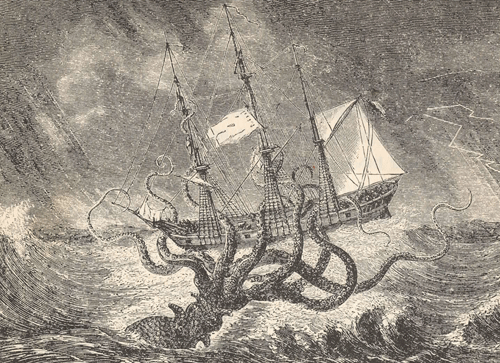
The Kraken Attacks!
From Jules Verne's 20,000 Leagues Under the Sea:
I looked in my turn, and could not repress a gesture of disgust. Before my eyes was a horrible monster worthy to figure in the legends of the marvellous. It was an immense cuttlefish[2], being eight yards long. It swam crossways in the direction of the Nautilus with great speed, watching us with its enormous staring green eyes. Its eight arms, or rather feet, fixed to its head, that have given the name of cephalopod to these animals, were twice as long as its body, and were twisted like the furies' hair. One could see the 250 air holes on the inner side of the tentacles. The monster's mouth, a horned beak like a parrot's, opened and shut vertically.Its tongue, a horned substance, furnished with several rows of pointed teeth, came out quivering from this veritable pair of shears. What a freak of nature, a bird's beak on a mollusc! Its spindle-like body formed a fleshy mass that might weigh 4,000 to 5,000 lb.; the, varying colour changing with great rapidity, according to the irritation of the animal, passed successively from livid grey to reddish brown. What irritated this mollusc? No doubt the presence of the Nautilus, more formidable than itself, and on which its suckers or its jaws had no hold. Yet, what monsters these poulps are! what vitality the Creator has given them! what vigour in their movements! and they possess three hearts! Chance had brought us in presence of this cuttlefish, and I did not wish to lose the opportunity of carefully studying this specimen of cephalopods. I overcame the horror that inspired me, and, taking a pencil, began to draw it.

Lusca
Thanks to the Disney movie, everyone knows of the Kraken. But around the Caribbean the giant squid like critter is known as the Lusca.
Some claim it is the cross between a giant shark and an octopus. Others say it more like a cross between giant squid and an eel. No matter how you describe this giant cuttlefish, it is believed to haunt the waters of the Caribbean. They lurk in the blue holes, a vast network of underwater caves, and they come out of them to feed on unsuspecting victims that wander to close or happen to startle their rest. They are especially active around the Bahamas but supposedly exist throughout the Caribbean Sea.
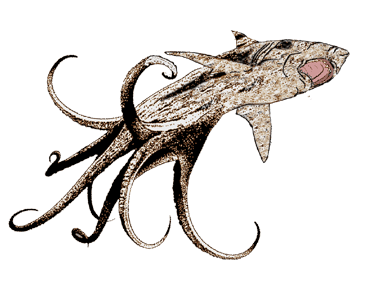
Few people survive an attack by the lusca. This vicious animal attacks a ship from below. The first sign of the attack is the whirlpool that forms under the ship. Then the lusca’s tentacles wrap around the ship and with a jerk it pulled into the depths of the ocean. As the whirlpool subsides, all that is left is what the lusca didn’t digest; perhaps a bit of wood or a sail or other items that would float to the surface. Lucky be the pirate who survives the Lusca! Or so the myth goes.

Mermaids
An imaginary, partly human sea creature with the head and trunk of a woman and the tail of a fish or cetacean. The word itself is Middle English (mere = sea and maid = young girl) is a legendary aquatic creature. Originally it seems there were just mermaids but as time passed we have counterparts for both sexes. The male are mermen and the collective noun is for these half fish/half humans is merfolk. Originally the Sirens of Greek mythology were simply beautiful women but later portrayals show them as mermaids. In some languages the word sirena is used interchangeably with mermaid.
By the 18th century, most people with any type of education considered tales of mermaids as nothing more than the work of over active imaginations, stories the old sea dog would tell to a young whelp to see if he would swallow the bait, so to speak. Yet some of the more superstitious and unschooled sailor may have fallen for the story.
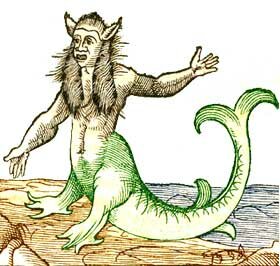
The mermaid was not always a creature of beauty. Image based on an early woodcut.
As we enter the Caribbean, Pirates may have heard the legends of the natives of the islands. Among the islands, mermaids were known as Aycayía, (the girl with the beautiful voice). The legends in the Caribbean are similar to those from other places of the World. Sometimes Aycayía was good and other times she was bad.
In the earlier legends, Mermaids would seduce or lure men to their death. Sometimes this was done on purpose and other times by accidents. At other times sailors were killed while mermaids tried to save their lives.
As early as the 1500s there was conjecture that manatees were the source of the mermaid myth. Manatees like to float along the ocean surface in relatively shallow water and are not overly scared of humans or large ships. In fact there slow peaceful existence has led to their endangerment as a species. In fact a close relative of the manatee, the stellar sea cow is now extinct.
Despite this explanation, there is no solid evidence that pirates would have mistaken the manatee for a mermaid. From a side by side comparison, one would assume, it would take a very drunk pirate to mistake a manatee for a beautiful mermaid! It is more likely that the manatee-mermaid connections were specualtions made far after most learned men had discounted mermaid sighting as just another "fish story". Still, it is part of the mythos
With that said, this modern day speculation of a mermaid/manatee connection by historians, environmentalists and manatee lovers helps to bring awareness to the plight of the endangered animal. And that is a good thing.

St. Elmo's Fire
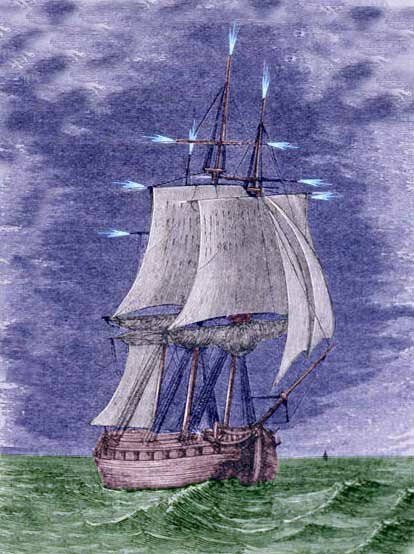
St. Elmo's Fire
St. Elmo's Fire is named after the Italian Saint Erasmus (Elmo in English). St. Erasmus is the patron saint of Mediterranean sailors. St. Elmo's Fire is a weather phenominon that occurs when a large amount of atmospehric electricity is present, usually before or after a thunder storm. It is usually seen as a good omen by men at sea, a sign that the very finger tips of God has come down from Heaven to protect the ship from danger.
St. Elmo's Fire appears as blue flame or sphere at the top of a ship's mast or masts, often for minutes at a time. It does not produce heat or cause things to burn. Sometimes the sphere will break up and dance along the yardarms and upper lines of the ship. On ships with more than one masts the flame may appear at the top of each mast or dance about like a blue flame licking the top of of all the sails.
Leave it to Ben Franklin to explain this naturally occurring condition in his work concerning electricity in the air and lightning. Basically as electricity builds up in the atmosphere before or storm or disippates after a storm it is attracted to the top of the masts which act as grounded lightning rods. The elctricity causes the tips to brightly glow in a blue or whitish blue light.
Despite Mr. Franklin's wisdom, the light is still seen today as a sign of good luck or fortune, escpecially when it appears near then en of a tempest. At that time, it is seen as a sign that St. Elmo has watched over the ship through the storm and answered the prayers of her crew.

Sea Spright (also Sprite)
A ghost of the sea. The word usually refers to disembodied spirit, a ghost; a supernatural being, goblin or fairy. They haunt ships that have troubled pasts, such as mutinies or perhaps a ship that had a cruel master who was murdered or was beleived to be in league with the Devil. Some people consider former slaves ships to be haunted because of their past cargo. Some sprights haunt spots where ships had sunk, basically creating "haunted waters”. Occasionally a spright will bring warning of impending doom or warn sailors to stay out of the waters but most tend to be vengeful and or troublesome. The word spright dates back to the 1500s and is an alliteration of the word "spirit".
Pirates would often offer a blessing to men they marooned or tossed a man overboard in an effort to bring rest to the soul of the condemned. If the person's soul did not find rest, it was feared they would return from Davy Jones as a sea spright. This was a reason why some ships would not return to islands where men had been marooned or to waters where murderous mutinies occurred or men were thrown overboard.

Sea-serpent
A sea-monster of serpentine form and great length, frequently reported to have been seen at sea. As history evolved and knowledge of dinosaurs and their aquatic cousin, plesiosaurs became more pronounced, the sea serpents began to take the shape of the long extinct reptiles. However, in the 18th century, the sea-serpent was more akin to a giant snake.
Early skeptics dismissed sea-serpents as tricks of light and lumps of sargassum (sea weed). Others claimed the sighting to be whales, schools of fish, dolphins, and seals. As with the kraken, the sea-serpent may actually be a living deep-sea creature, however smaller than the accounts given by sailors of old. The oarfish fits the role of the original sea-serpent quite nicely. Reaching lengths of 8 meters (26 feet)[3] and weighing as much as 270 kg (600 pounds) could give superstitious pirate a bad night's sleep.
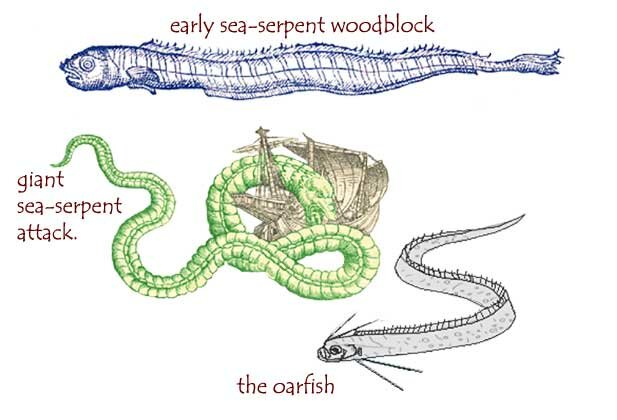
Selky (Selkies)
Imagine a werewolf that is a seal, but it is noy contagious. Selkies are able to transform to human form by shedding their seal skins and can revert to seal form by putting their selkie skin back on. Stories concerning selkies are generally romantic tragedies. Sometimes the human will not know that their lover is a selkie, and wakes to find them gone. Other times the human will hide the selkie's skin, thus preventing them from returning to seal form. A selkie can only make contact with one particular human for a short amount of time before they must return to the sea. Stories of the Selkies seem to originate in Scotland.
[1] Credulity: Over-readiness to believe; disposition to believe on weak or insufficient grounds.
[2] Cuttle-fish are cephalopod of the genus Sepia or family Sepiidæ, also called ink-fish from its power of ejecting a black fluid from a bag or sac, so as to darken the water and conceal itself from pursuit. The name is sometimes extended to other decapod (10 legged) , and sometimes even to octopod (8 legged), cephalopods. Cuttle-fish are cousins to octopii and squids.
[3] Unverified reports have reached lengths of 17 meters, about 66 feet.

The only author and editor of all pages on the site. Most of what I write about is based on years of book reading on the topic. My first web page was published back in 1994.